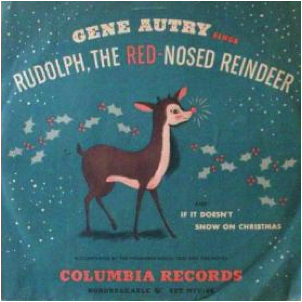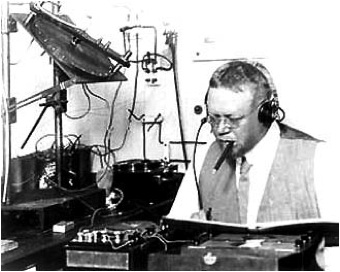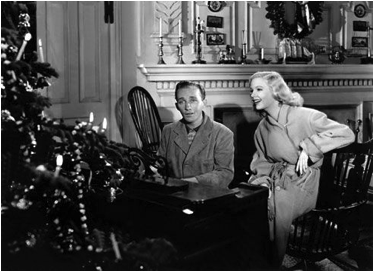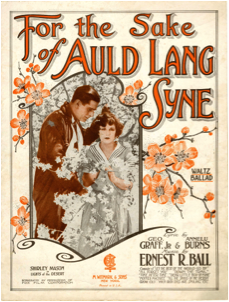It’s the most wonderful time of the year, when the airwaves are filled with holiday cheer!
 The soundtrack of the holiday season is filled with timeless classics, some of which have endured for over a hundred years. You’ve heard them all a thousand times but the stories behind some of these holiday standards may surprise you. So take a break from trimming the tree and read on to discover 8 facts about these classic holiday songs.
Meet the Man Behind Dozens of Holiday Songs
The soundtrack of the holiday season is filled with timeless classics, some of which have endured for over a hundred years. You’ve heard them all a thousand times but the stories behind some of these holiday standards may surprise you. So take a break from trimming the tree and read on to discover 8 facts about these classic holiday songs.
Meet the Man Behind Dozens of Holiday Songs Prominent Jewish songwriter Johnny Marks penned dozens of Christmas classics, including “Rockin’ Around the Christmas Tree,” “A Holly Jolly Christmas” and “Silver and Gold.” However, his most enduring work is “Rudolph the Red-Nosed Reindeer.” This tune celebrating the world’s most famous reindeer was based on a coloring book originally released by department store Montgomery Ward in 1939.
The Grinch’s Singing Stunt Double was Tony the Tiger
Prominent Jewish songwriter Johnny Marks penned dozens of Christmas classics, including “Rockin’ Around the Christmas Tree,” “A Holly Jolly Christmas” and “Silver and Gold.” However, his most enduring work is “Rudolph the Red-Nosed Reindeer.” This tune celebrating the world’s most famous reindeer was based on a coloring book originally released by department store Montgomery Ward in 1939.
The Grinch’s Singing Stunt Double was Tony the Tiger “You’re a Mean One, Mr. Grinch” is the iconic song of the Christmas story How the Grinch Stole Christmas! Originally written by Theodor “Dr. Seuss” Geisel and Albert Hague for the 1966 cartoon special, the song was performed by Thurl Ravenscroft, the same actor who was the voice of Tony the Tiger and various Disney characters. Even though the Grinch’s scenes were performed by Boris Karloff, who also served as the narrator, Karloff could not sing and Ravenscroft had to step in. Unfortunately, Ravenscroft was not named in the ending credits and Dr. Seuss himself apologized to the actor for the oversight and asked media columnists to acknowledge Ravenscroft’s work.
Bing Crosby’s Record-Setting Classic
“You’re a Mean One, Mr. Grinch” is the iconic song of the Christmas story How the Grinch Stole Christmas! Originally written by Theodor “Dr. Seuss” Geisel and Albert Hague for the 1966 cartoon special, the song was performed by Thurl Ravenscroft, the same actor who was the voice of Tony the Tiger and various Disney characters. Even though the Grinch’s scenes were performed by Boris Karloff, who also served as the narrator, Karloff could not sing and Ravenscroft had to step in. Unfortunately, Ravenscroft was not named in the ending credits and Dr. Seuss himself apologized to the actor for the oversight and asked media columnists to acknowledge Ravenscroft’s work.
Bing Crosby’s Record-Setting Classic The best-selling song of all time may take you by surprise; Bing Crosby’s career defining classic “White Christmas” holds the number one spot. The tune, written by Irving Berlin, was originally recorded by Crosby to promote the 1942 film Holiday Inn, and it spent eleven weeks on top of the Billboard charts. It made a swift return to the top of the charts in 1945 and 1946, making it the only song to ever top the U.S. charts three separate times.
“O Holy Night” Was the Second Song Ever Broadcast on Radio
The best-selling song of all time may take you by surprise; Bing Crosby’s career defining classic “White Christmas” holds the number one spot. The tune, written by Irving Berlin, was originally recorded by Crosby to promote the 1942 film Holiday Inn, and it spent eleven weeks on top of the Billboard charts. It made a swift return to the top of the charts in 1945 and 1946, making it the only song to ever top the U.S. charts three separate times.
“O Holy Night” Was the Second Song Ever Broadcast on Radio Nowadays we take radio broadcasts for granted, but there was a time when transmitting music over the air was an extraordinary feat. After years of research and experimentation Canadian inventor Reginald Fessenden broadcast the first ever AM radio program on Christmas Eve, 1906. The second song to be heard during the broadcast was “O Holy Night,” performed by Fessenden on violin.
Original Meaning of “The Dreidel Song”
Nowadays we take radio broadcasts for granted, but there was a time when transmitting music over the air was an extraordinary feat. After years of research and experimentation Canadian inventor Reginald Fessenden broadcast the first ever AM radio program on Christmas Eve, 1906. The second song to be heard during the broadcast was “O Holy Night,” performed by Fessenden on violin.
Original Meaning of “The Dreidel Song”  “The Dreidel Song,” also known as “Dreidel, Dreidel, Dreidel,” is popular among children during the festival of Chanukah. While the well-known English version is about crafting a dreidel out of clay and playing with it, the original Yiddish version is quite different. The Yiddish song “Ikh Bin a Kleyner Dreydl” is written from the dreidel’s point of view, encouraging children to play along. Another notable difference in the Yiddish version is the dreidel is made out of lead, not clay.
“Silver Bells” Started as “Tinkle Bells”
“The Dreidel Song,” also known as “Dreidel, Dreidel, Dreidel,” is popular among children during the festival of Chanukah. While the well-known English version is about crafting a dreidel out of clay and playing with it, the original Yiddish version is quite different. The Yiddish song “Ikh Bin a Kleyner Dreydl” is written from the dreidel’s point of view, encouraging children to play along. Another notable difference in the Yiddish version is the dreidel is made out of lead, not clay.
“Silver Bells” Started as “Tinkle Bells” The classic tune “Silver Bells” was originally written as “Tinkle Bells” by legendary composers Jay Livingston and Ray Evans. It quickly changed to “Silver Bells” after Livingston’s wife pointed out that “tinkle” had a double meaning and was not a great idea for a holiday song. The song was first recorded and released by Bing Crosby and Carol Richards in 1950.
Santa’s First Musical Appearance
The classic tune “Silver Bells” was originally written as “Tinkle Bells” by legendary composers Jay Livingston and Ray Evans. It quickly changed to “Silver Bells” after Livingston’s wife pointed out that “tinkle” had a double meaning and was not a great idea for a holiday song. The song was first recorded and released by Bing Crosby and Carol Richards in 1950.
Santa’s First Musical Appearance
 The first song to ever mention Santa Claus is “Up on the Housetop” written by Benjamin Hanby in 1864. Hanby likely got the idea of Santa landing his sleigh up on the roof from the classic poem The Night Before Christmas, which was written by Clement C. Moore in 1822. Of course, Santa would go on to make appearances in dozens of holiday songs, including “Santa Claus is Coming to Town,” which later inspired a television special starring Fred Astaire.
A New Year’s Eve Tradition Began in New York City
The first song to ever mention Santa Claus is “Up on the Housetop” written by Benjamin Hanby in 1864. Hanby likely got the idea of Santa landing his sleigh up on the roof from the classic poem The Night Before Christmas, which was written by Clement C. Moore in 1822. Of course, Santa would go on to make appearances in dozens of holiday songs, including “Santa Claus is Coming to Town,” which later inspired a television special starring Fred Astaire.
A New Year’s Eve Tradition Began in New York City “Auld Lang Syne” dates back to 1788 when it was written by Scotland’s Robert Burns. Singing it soon became one of Scotland’s New Year’s traditions. However, it didn’t catch on in America until 1929 when Canadian bandleader Guy Lombardo landed the headline gig at the Roosevelt Hotel’s New Year’s Eve celebration. His midnight performance of “Auld Lang Syne” was broadcast across the airwaves on the new medium of radio, and thus a tradition was born. Lombardo’s performance can still be heard every year during the annual ball drop in Times Square.
What’s your favorite holiday song? Tell us in the comments below!
“Auld Lang Syne” dates back to 1788 when it was written by Scotland’s Robert Burns. Singing it soon became one of Scotland’s New Year’s traditions. However, it didn’t catch on in America until 1929 when Canadian bandleader Guy Lombardo landed the headline gig at the Roosevelt Hotel’s New Year’s Eve celebration. His midnight performance of “Auld Lang Syne” was broadcast across the airwaves on the new medium of radio, and thus a tradition was born. Lombardo’s performance can still be heard every year during the annual ball drop in Times Square.
What’s your favorite holiday song? Tell us in the comments below!
Published
15th December 2015